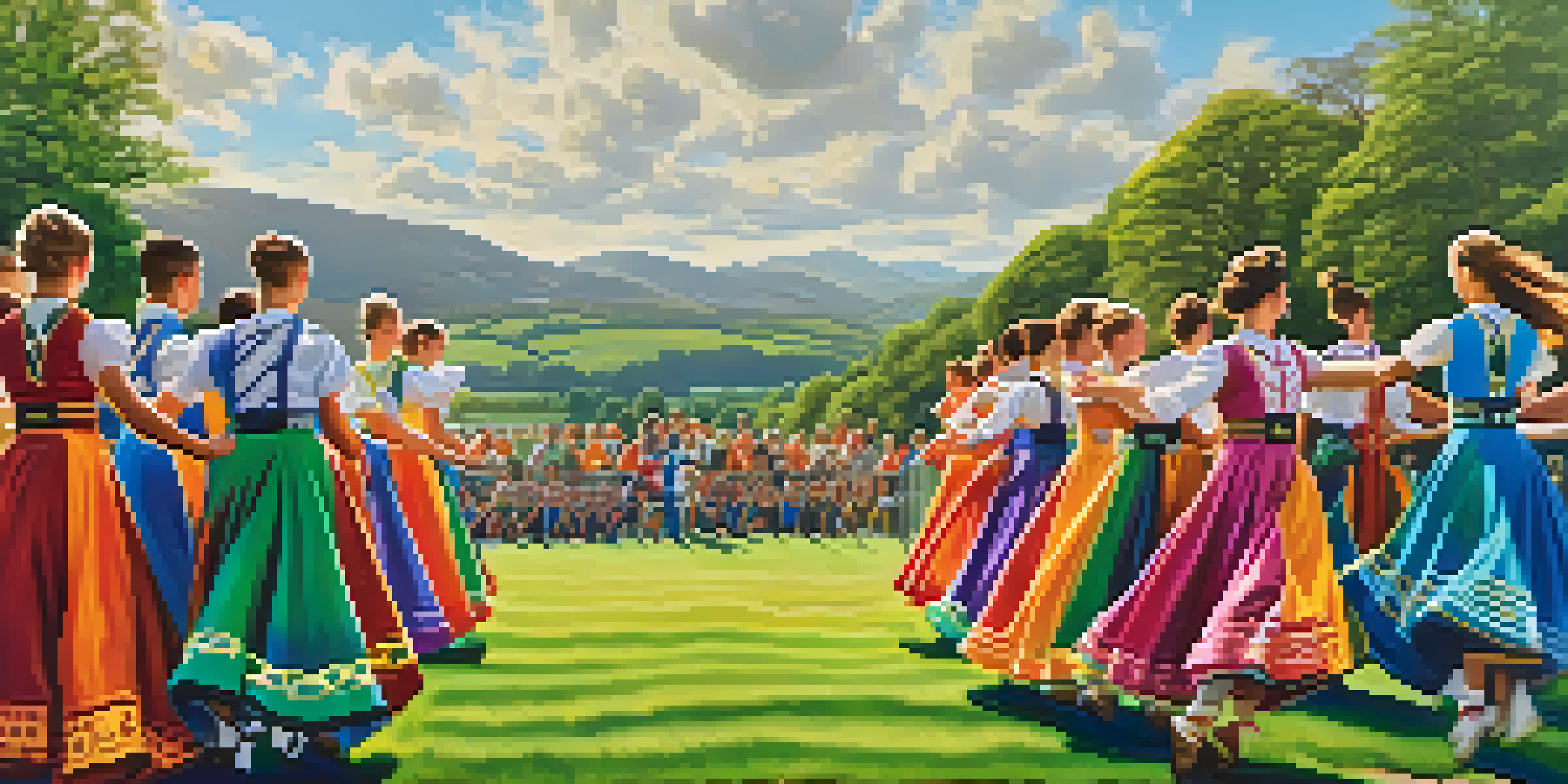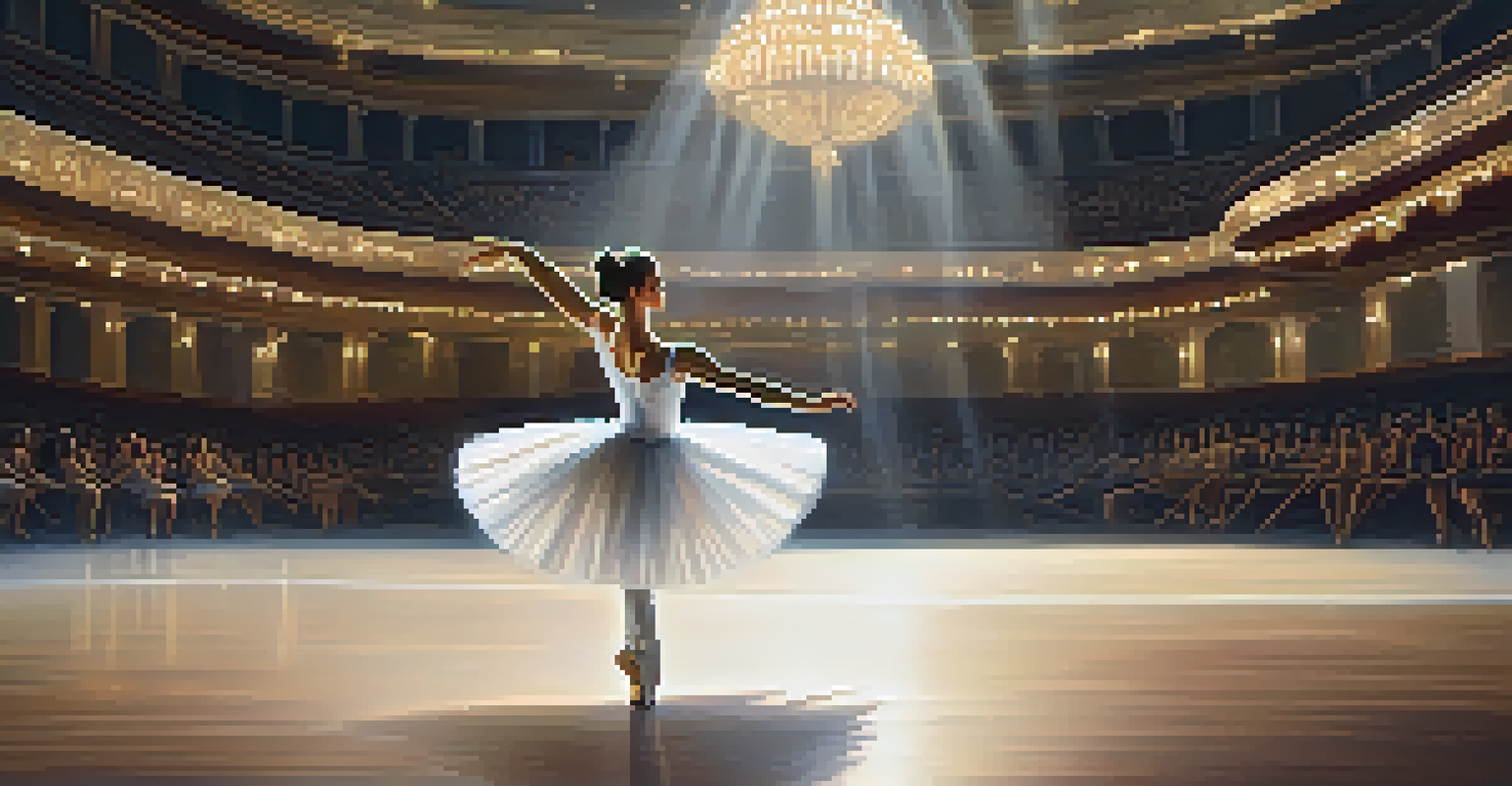Dance Genres and Their Folklore Connections Worldwide

The Rich Tapestry of Dance and Folklore
Dance is more than just movement; it tells stories, preserves traditions, and connects people. Each dance genre is often deeply intertwined with the folklore of its culture, serving as a vessel for history and values. Whether it's a lively jig or a solemn ritual, the essence of a community is often expressed through its dance forms.
Dance is the hidden language of the soul.
For instance, the traditional dances of Indigenous peoples often convey their relationship to nature and spirituality. Through movements and rhythms, they celebrate seasons, harvests, and significant life events. This connection not only honors their ancestors but also educates younger generations about their heritage.
By exploring the folklore behind various dance genres, we can appreciate the diversity and depth of human expression. Each dance style offers a glimpse into the soul of a community, reflecting their joys, struggles, and aspirations.
Ballet: Elegance Rooted in History
Ballet, often seen as the epitome of grace, has its roots in the royal courts of Renaissance Italy. It evolved into a theatrical art form in France and Russia, where stories were conveyed through elaborate movements and stunning costumes. The folklore in ballet is rich, with many works inspired by fairy tales and myths, such as 'Swan Lake' and 'The Nutcracker.'

These performances often weave narratives of love, conflict, and transformation, tapping into universal themes that resonate across cultures. The use of classical music in ballet further enhances its storytelling, allowing the audience to feel the emotions conveyed through each pirouette and arabesque. The connection to folklore here is both direct and interpretive, as the stories themselves often have roots in cultural myths.
Dance as Cultural Storytelling
Dance serves as a powerful medium for communities to express their history, values, and emotions through movement.
Today, ballet continues to evolve, incorporating contemporary themes while still honoring its historical foundations. This blend of old and new keeps the art form relevant, allowing it to resonate with modern audiences while still celebrating its rich heritage.
Flamenco: Rhythm of the Spanish Soul
Flamenco is a passionate dance genre that originated in the Andalusian region of Spain, steeped in the folklore of the Romani people, Moors, and Jews. This expressive art form combines intricate footwork, clapping, and guitar music to convey deep emotion and storytelling. Each performance is a reflection of the dancer's personal journey, often infused with themes of love, loss, and resilience.
The dance is a poem of which each movement is a word.
The spirit of flamenco lies in its improvisational nature, allowing dancers to connect with their audience in real time. This connection is reminiscent of oral traditions, where stories are shared and emotions are felt collectively. The vibrant costumes and rhythmic clapping further enhance the cultural richness, making flamenco a celebration of life itself.
As flamenco continues to gain global popularity, it remains a powerful reminder of its origins and the cultural tapestry from which it emerged. Dancers and musicians honor their heritage while also inviting new influences, creating a dynamic art form that evolves yet stays true to its roots.
Irish Dance: Celebrating Community and Heritage
Irish dance is a vibrant expression of community, often performed at social gatherings, festivals, and competitions. Its roots can be traced back to ancient Celtic traditions, where dance was a communal activity that brought people together. This genre is characterized by its rapid leg and foot movements while keeping the upper body relatively still, creating a striking visual contrast.
The folklore associated with Irish dance is rich with tales of mythological heroes and historical events. Dances like the 'Riverdance' and 'Lord of the Dance' have popularized this art form worldwide, showcasing its cultural significance. The music, typically featuring fiddles and bodhráns, enhances the storytelling aspect, drawing audiences into the narrative.
Folklore Enriches Dance Traditions
Many dance forms are deeply rooted in folklore, reflecting the cultural narratives and spiritual themes of their origins.
Today, Irish dance continues to thrive, with both traditional and contemporary styles being celebrated. While competitions and performances may seem modern, they are rooted in the age-old tradition of passing down stories through movement, making each dance a celebration of heritage.
Indian Classical Dance: A Spiritual Journey
Indian classical dance encompasses a variety of styles, each with its own unique history and connection to folklore. These dances, such as Bharatanatyam, Kathak, and Odissi, are often based on ancient texts and religious stories, embodying spiritual themes and cultural narratives. Through intricate movements and expressive facial gestures, dancers convey profound emotions and tales of deities, love, and devotion.
The storytelling aspect of Indian classical dance is deeply rooted in the oral traditions of India. Dancers often draw inspiration from epics like the Ramayana and Mahabharata, bringing these ancient stories to life through their art. This connection to folklore not only preserves cultural heritage but also educates audiences about the rich tapestry of Indian mythology.
As global interest in Indian classical dance grows, artists are finding new ways to blend tradition with contemporary influences. This evolution helps to keep the art form dynamic while honoring its spiritual and cultural foundations, allowing new generations to connect with their roots.
African Dance: A Celebration of Life and Community
African dance is as diverse as the continent itself, with each region boasting its own unique styles and traditions. These dances often serve communal purposes, celebrating events such as harvests, weddings, and initiations. The movements are typically energetic and rhythmic, reflecting the deep connection to music and community.
Many African dances are rooted in folklore, telling stories of ancestors, nature, and daily life. For instance, the Adumu dance of the Maasai people is performed during ceremonies to showcase bravery and strength. By participating in these dances, individuals honor their heritage while fostering a sense of unity and belonging within their community.
Global Evolution of Dance Forms
As traditional dances gain global recognition, they continue to evolve, blending contemporary influences while honoring their cultural heritage.
As African dance gains recognition worldwide, it continues to inspire artists across genres. The blending of traditional movements with contemporary styles creates a rich dialogue between the past and the present, showcasing the enduring power of dance to connect people and cultures.
The Global Influence of Folk Dances
Folk dances are a reflection of the daily lives and traditions of the communities they originate from. From the lively polka in Eastern Europe to the graceful hula in Hawaii, these dances provide insight into cultural practices and social values. They often serve as a means of storytelling, passing down legends, and celebrating significant life events.
The beauty of folk dances lies in their ability to bring people together, transcending language and cultural barriers. Many of these dances have been adapted and incorporated into contemporary performances, allowing them to evolve while maintaining their roots. As a result, folk dances have a unique ability to connect diverse audiences through shared experiences.

In a world that is increasingly interconnected, the appreciation of folk dances continues to grow. By understanding and participating in these dances, individuals can foster a greater sense of cultural awareness and appreciation, celebrating the rich heritage that each dance embodies.